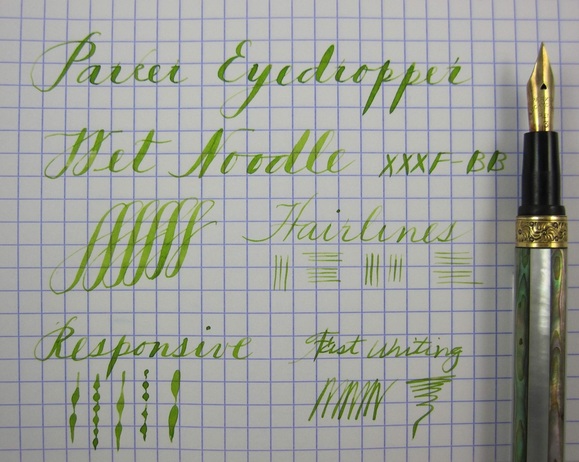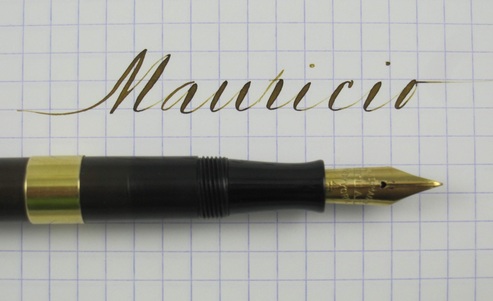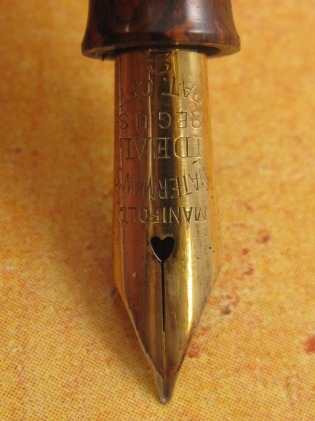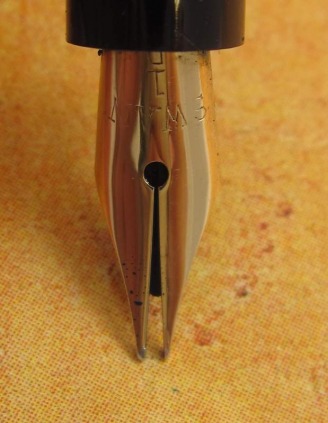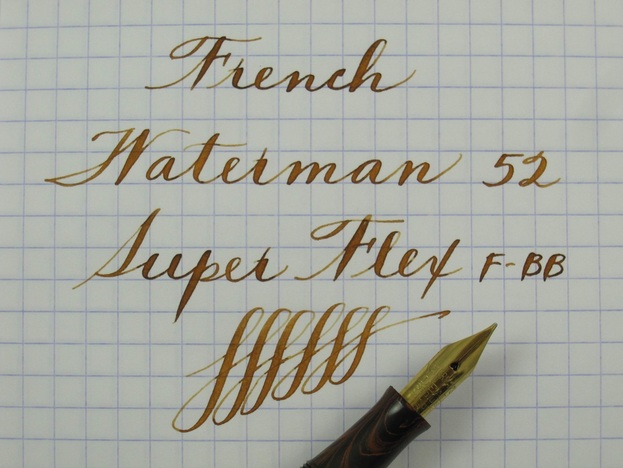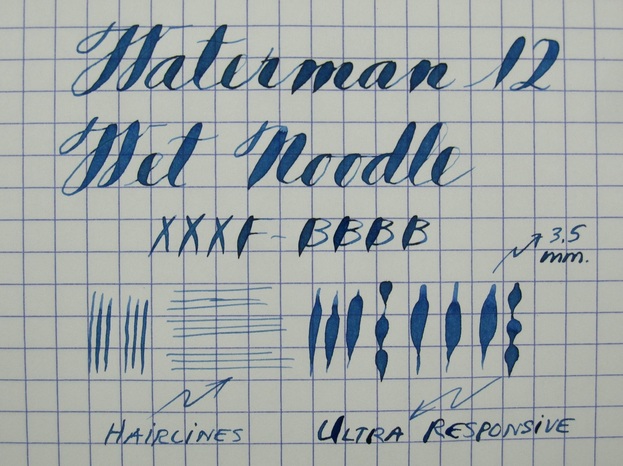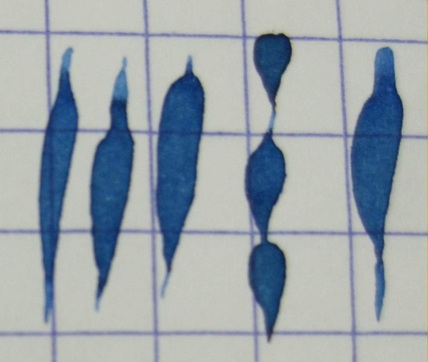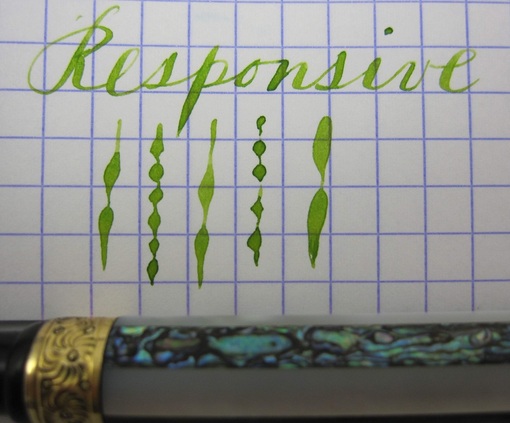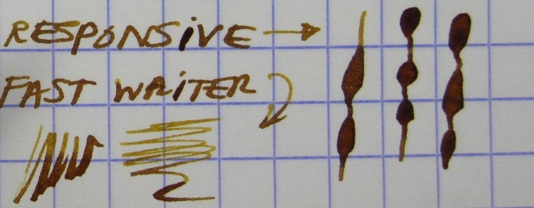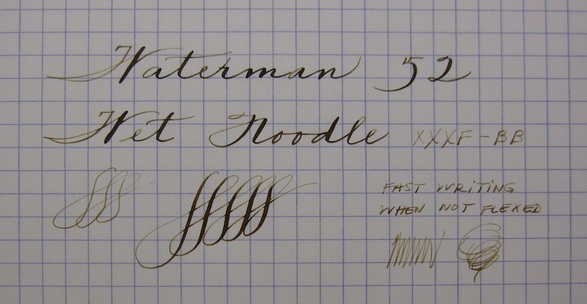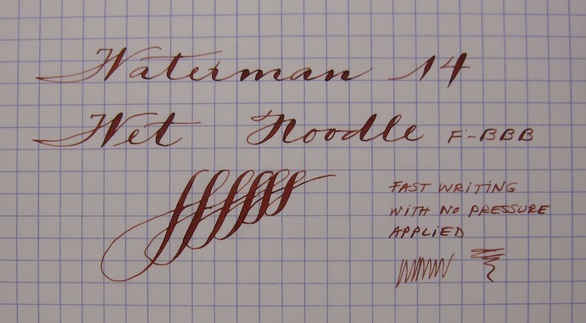Grading Flexible Nibs
_______________________________________________________________________________________________
Updated on October 5, 2012
Flexible Nib Specification
No two flexible nibs are 100% identical. I like to say that flexible nibs are like individuals with their own "personality" and "temperament." This wide range of differences among flexible nibs makes their grading much more complicated than grading fountain pen bodies ... and a very subjective topic. I have seen multiple pen enthusiasts having a hard time agreeing on what a fine nib is or should be. Add three more dimensions to that criteria (Flexibility of the nib, line variation the nib can produce, and "snap-back") and you have a really subjective matter.
As subjective as grading flexible nibs can be, be also aware about lots of misinformation on flexible nibs available out there. Some individuals have from zero to very little experience and knowledge on the subject of flexible nibs, but they feel compelled to make reviews, videos, evaluations, comparissons and recommendations about flexible nibs. Being capable of doing some doodles and a couple of "chicken-scratch" lines with a flexible nib does not warrant anyone to mislead others about flexible nibs for fountain pens. Do not be deceived by those who do not have the required level of experience and knowledge on the subject. That incorrect information might lead into unpleasant experiences and may even turn you away from the wonderful world of flexible nibs and flexible writing. Be discerning and use sound judgement. Put your trust on reliable sources only.
Like the pen grading criteria in the previous page, the nib specification provided below is not, in any way, official nib specification, but a great reference tool as you consider the purchase of a fountain pen from this website.
Nib specification is listed in four different types of categories in this wesbite: (1) Nib width; (2) Nib flexibility, if any; (3) Line variation of the nib, if any; (4) Nib "Snap-back"
(1) Nib Width:
Fountain pen and nib manufacturers have never used standardized nib widths. What a pen or nib manufacturer in Japan calls a broad nib is what an American manufacturer may call a medium nib, and what an European manufacturer may call a fine nib. The actual width of nibs will also vary from one manufacturer to another, even if both of those pens or nib makers are in the same country and continent. A less ambiguous way to refer to nib widths is to use actual dimensions. Below you can find the nib width standards I use for all the nibs in vintage pens listed in this website. Any eventual modern pen listed in this website will certainly have different widths than the dimensions outlined below:
- TRIPLE EXTRA FINE (XXXF) ... approximately 0.1 mm
- DOUBLE EXTRA FINE (XXF) ... approx. 0.2 mm
- EXTRA FINE (XF) ... approx. 0.3 mm
- FINE (F) ... approx. 0.45 mm
- MEDIUM (M) ... approx. 0.6 mm
- BROAD (B) ... approx. 0.9 mm
- DOUBLE BROAD (BB) ... approx. 1.2 mm
- TRIPLE BROAD (BBB) ... approx. 1.8 mm
In addition to the actual nib width, the following factors will affect the actual line width of the writing:
- The amount of pressure applied when writing. The more pressure, the wider the line.
- The speed of writing. The slower the speed, the wider the line.
- The pen/nib setup. The more inkflow in the pen/nib setup, the wider the line.
- Paper. The more absorbent the paper, the wider the line.
- Ink. Different inks have different properties, which may alter the line width of the writing.
- The humidity of the air and humidity of the paper. The more humid, the wider the line.
(2) Nib Flexibility:
The flexibility of a nib is the level of springiness of the nib tines while applying pressure to the nib or the amount of pressure applied to spread and arch the tines of a nib. There are multiple levels of nib springiness or nib flexibility. A more concrete way to quantify that level of springiness or amount of pressure applied onto a nib is to use a "flexibility scale" from zero to 100. In that scale, zero corresponds to a rigid nib while wet noodle nibs get the highest rankings within that scale. The definition of each flexibility level and where they fit within the flexibility scale are as follows:
- FIRM (Flexibility scale = Zero): Rigid nib with no springiness or flexibility at all. Also known as a “nail”
- SLIGHT FLEX (Flexibility scale ranging from 1 to 30) : The nib tines flex modestly with substantial pressure applied.
- MEDIUM FLEX (Flexibility scale from 31 to 60): The nib tines flex significantly with substantial pressure applied. Also known as “semi-flex”
- SUPER FLEX (Flexibility scale from 61 to 80): The nib tines flex tremendously with moderate to substantial pressure applied.
- WET NOODLE (Flexibility scale from 81 to 100): The nib tines flex tremendously even with very little to moderate pressure applied. This nib resembles a paint brush.
All wet noodle nibs are rare and hard to find. Most wet noodle nibs fall in the flexibility scale from 81 to 90. Wet noodle nibs between 91 and 95 are even rarer, and wet noodles between 96 and 100 are the rarest among the rarest. Expect to pay dearly for any wet noodle ranging from 91 to 100 in the flexibility scale ... and that is if you can find one available for sale!
CAUTION: Please do not attempt to flex the tines of your nib to its maximum capabilities unless you know what you are doing. You can misalign, bend or break your nib beyond repair. It is not worth to damage a flexible nib just to see its maximum flexying capabilities. Over time and with much practice, your skills to determine the degree of flexibility in a nib will become more natural.
As mentioned earlier, each flexible nib has its own "personality" and "temperament." Some nibs may deceive you as to how flexible they are due to how they "feel." And this feel might have a lot to do with additional factors such as how smooth the nib is, how rounded the tipping in the nib is, inkflow, the size of the nib, a new nib you have never written with Vs. a nib you are very familiar with, etc. Likewise, there are nibs that are not as flexible in their initial spreading of the tines, but once they reach a certain treshhold those nibs flex easily. I have had the privilege to handle and write with a very vast universe of flexible nibs. As such, I like to savor the unique attributes that each individual flexible nib has to offer.
The most common misnomer in the word of flexible nibs is the misuse of the term "semi-flex." Lots of pens enthusiasts with no knowledge on flexible nibs refer to all flexible nibs as "semi-flex" and that does not necessarily mean those nibs are "medium flex." The misuse of the term "semi-flex" is the equivalent of calling all firm nibs "medium" while in reality firm nibs can be from XXXF to BBB, obliques, italics, music nibs, etc.
Do not be mislead by claims that the way to determine a nib's flexibility is by finding out how many times the nib increases its line thickness. Some people make claims such as "a semiflex nib can increase the thickness of the line by 3x and an extra-flex by 5x." Statements like those are 100% inaccurate. The nib's ability to or achieve any multiplier of its original line width is called LINE VARIATION (explained right below this topic) and it has nothing to do with the actual degree of flexibility of a nib.
Likewise, do not be mislead by pictures or videos. What you see in pictures and videos is the actual LINE VARIATION a nib can produce. Neither pictures nor videos give you concrete information as to how much pressure the writer applied when doing those writings. In a video, you will get a "video illusion" as to how flexible a nib is. I call it illusion because what you see is line variation and the dexterity of the writer: The more skilled the writer or the wider the line variation in those writings, the more inclined is someone to believe that is a more flexible nib. However, making another video with that same nib and in the hands of an inexperienced flexy writer would give you the perception that very same nib is not nearly as flexible ... and that perhaps it is a scratchy and faulty nib as well. Those diametrical opposite impressions when watching videos have nothing to do with the degree of flexibility of the nib. They are video illusions.
There are also individuals claiming to be able to measure the flexibility of a nib by doing flexible writing on top of a scale. This is also a very flawed approach. If you write on top of a scale, a significant part of the pressure applied when writing is transferred onto your hand, arm and shoulder and the scale cannot measure that. Using a scale to measure nib flexibility would be like attempting to weight a heavy suitcase on a scale while you are partially lifting the suitcase with your hand. You can make the scale read the suitcase's full weight or as little as zero weight, solely depending on how much weight rests on your hand, arm and shoulder.
The only way to determine the actual flexibility of a nib is by a very well trained hand on the subject of flexible nibs. Once an individual has written with a huge array of flexible nibs for fountain pens, including the most flexible ones and gained substantial knowledge and experience on the nuances of flexible nibs, then that individual can start making more informed and educated determinations about the degree of flexibility of nibs.
(3) Line Variation of the Nib:
Line variation must not be confused with flexibility of the nib. While flexibility of the nib is how much flexibility the nib has while applying pressure, line variation of the nib is the line range a flexible nib will produce under different degrees of pressure applied and regardless of the nib’s degree of flexibility.
For example: One medium flex nib is only capable to write an XXXF-BBB line, while a different medium flex nib is capable of an F-BB line. Another example would be a super flex nib capable to write a M-BB while a second superflex nib can do an XF-B and a third superflex nib can get an XXF-BB. That minimum and maximum line widths a flexible nib can produce are the actual line variation. And line variation is exactly what you see in a picture and a video of a writing sample.
Wet Noodle Nib #1
Line Variation from XXXF to BBBB
Line Variation from XXXF to BBBB
Wet Noodle Nib #2
Line Variation from XF to BB

Superflex Nib #1
Line Variation from M to BB

Superflex Nib #2:
Line Variation from XXF to BB
Line Variation from XXF to BB
(4) Nib "Snap-Back":
Nib "snap-back" is how quick the nib is able to regain its original shape after releasing pressure. Also known as nib responsiveness.
Additional Nib Grading Criteria
"Normal Nib When Not Flexed" ... There are flexible nibs which only allowed you to write at a slow writing speed. If you attempt to write at a normal speed, the tines go everywhere, splash ink everywhere and become very scratchy. However, there are exceptional flexible nibs that are: (1) Capable of flexible writing when the nib is flexed, and also (2) capable to write like a normal nib and as fast as you can when no flex is applied to the nib. These "normal nib when not flexed" are some of the nicest flexible nibs to write with as they are very forgiving to both, the experienced and unexperienced flexy writer. It is like having two pens/nibs in one.
"Professional" nib .... When you see this term in a pen listing, it indicates the nib requires tremendous skill to write and control the nib. They are ultra thin and ultra soft nibs, capable of making the thinnest hairlines combined with thick lines, a real joy to professional calligraphers and artists. A very light and steady hand combined with extremely slow writing speed are needed to properly control these nibs. Professional nibs are not your usual flexy nibs for regular daily use or for the amateur. They are for professionals as the name implies. Please do not attempt to venture into flexy writing with one of these nibs. To someone who is not highly skilled with one of these nibs, the nib will seem faulty or scratchy. It is not. They are just extremely hard to control and very fragile. One or a few bad strokes and the nib is damaged beyond repair. Please do not underestimate how hard these nibs are to control. I have a hard time writing with them myself, if that tells you something.
_______________________________________________________________________________________________
Copyright © 2009 - 2023 Mauricio Aguilar. All Rights Reserved.
Copyright notice: All photographs, written descriptions, flex nib specification, and content appearing in this website are the property of Mauricio Aguilar. They are protected by U.S. copyright laws, and are not to be downloaded or reproduced in any way without the written permission of Mauricio Aguilar. Buying an item does not entitle the buyer to use the photographs, the written description and the flex nib specification information.
Copyright notice: All photographs, written descriptions, flex nib specification, and content appearing in this website are the property of Mauricio Aguilar. They are protected by U.S. copyright laws, and are not to be downloaded or reproduced in any way without the written permission of Mauricio Aguilar. Buying an item does not entitle the buyer to use the photographs, the written description and the flex nib specification information.
